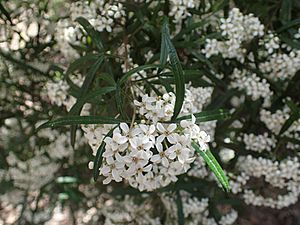Tree zieria facts for kids
Quick facts for kids Tree zieria |
|
|---|---|
 |
|
| Zieria arborescens leaves and flowers | |
| Scientific classification | |
| Genus: |
Zieria
|
| Species: |
arborescens
|
The Zieria arborescens, often called the tree zieria or stinkwood, is a plant that belongs to the citrus family called Rutaceae. It is found only in eastern Australia. This plant can be a bushy shrub or a small tree. Its branches are ridged and might feel scaly or hairy, especially when they are young. It has leaves made up of three smaller parts called leaflets. Its flowers are white and grow in groups, usually shorter than the leaves. Each flower has four petals.
About the Tree Zieria
The tree zieria (Zieria arborescens) is a strong shrub or a small tree. It can grow to be about 5 to 10 meters (16 to 33 feet) tall. Its branches have ridges where old leaves used to be. They are usually scaly or hairy, especially when they are young.
The leaves are made of three leaflets. These leaflets can be different sizes and shapes. Most are shaped like a spear or are oblong. They are about 50 to 90 millimeters (2 to 3.5 inches) long and 6 to 15 millimeters (0.2 to 0.6 inches) wide. The leaf stalk is about 15 to 30 millimeters (0.6 to 1.2 inches) long. The edges of the leaves usually curl downwards. The top side of the leaf is dark green and smooth. The bottom side is hairy and light in color. Both sides of the leaf have tiny oil glands.
The flowers are white or light pink. They grow in large groups where the leaves meet the stem (called the leaf axil). These flower groups are usually shorter than the leaves. Each flower has four small, somewhat hairy, triangular parts called sepals. These are about 1.5 to 2.5 millimeters (0.06 to 0.1 inches) long. The four petals are about 3 to 6.5 millimeters (0.1 to 0.3 inches) long and slightly hairy. Like other zieria plants, it only has four stamens.
Flowering happens from September to November. After the flowers, a seed capsule forms. This capsule holds seeds that have a special part called an elaiosome. This part attracts ants, which helps spread the seeds.

How It Got Its Name
The Zieria arborescens was first officially described in 1811. This was done by an English plant expert named John Sims. His description was published in a magazine called Botanical Magazine. The first plant specimen he studied came from Joseph Banks's collection in London.
The second part of the plant's scientific name, arborescens, comes from a Latin word. The Latin word arbor means "tree." The ending -escens means "about to become" or "almost." So, arborescens means "almost a tree" or "tree-like."
Scientists have described three main types (subspecies) of Zieria arborescens:
- Zieria arborescens subsp. arborescens
- Zieria arborescens subsp. decurrens
- Zieria arborescens subsp. glabrifolia
Where Does It Grow?
This type of zieria plant is found in several parts of Australia. It grows in Queensland, New South Wales, Victoria, and Tasmania. You can find it in wet forests and at the edges of rainforests.
One of the subspecies, glabrifolia, only grows in the New England Tablelands. This area is between the Girraween National Park in Queensland and Torrington in New South Wales. Another subspecies, decurrens, has only been found near Jervis Bay. It grows in drier eucalyptus areas. This type has ridged, non-warty branches and more hairs on its young branchlets.
Images for kids


